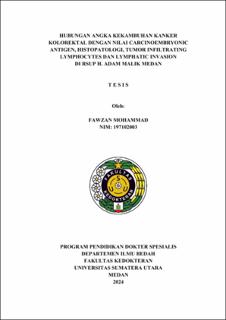Hubungan Angka Kekambuhan Kanker Kolorektal dengan Nilai Carcinoembryonic Antigen, Histopatologi, Tumor Infiltrating Lymphocytes dan Lymphatic Invasion Di RSUP H. Adam Malik Medan
Association of Colorectal Cancer Recurrence Rate with Carcinoembryonic Antigen Value, Histopathology, Tumor Infiltrating Lymphocytes and Lymphatic Invasion at H. Adam Malik General Hospital Medan

Date
2025Author
Mohammad, Fawzan
Advisor(s)
Muhar, Adi Muradi
Siregar, Edwin Saleh
Metadata
Show full item recordAbstract
Colorectal cancer is a prevalent cancer with more than 1.9 million new cases and nearly 935,000 deaths worldwide each year. Key factors in assessing colorectal cancer include tumor differentiation grade, lymphatic invasion, and tumor-infiltrating lymphocytes (TILs). Methods: This study analyzed medical records of colorectal cancer patients at Haji Adam Malik General Hospital Medan from 2023 to 2024. This study focused on understanding the relationship between recurrence rate and carcinoembryonic antigen (CEA) levels, histopathology, TILs, and lymphatic invasion. The data used were at least 40 patients, and statistical analysis was performed using SPSS software. Results: Recurrence Rate: On average, patients experienced a recurrence rate of 0.56, with incidence ranging from 0 to 2 times. CEA Levels: 68.9% of patients had CEA levels above 5 ng/L, indicating higher levels of the cancer marker, while 31.1% had levels below this threshold. Histopathology: The most common tumor grade was moderately differentiated (46.7%). Well-differentiated and poorly differentiated tumors were less common, at 26.7% each. TIL: Most patients had moderate TIL infiltration (37.8%), with 28.9% having mild infiltration, 24.4% having severe infiltration, and 8.9% having no infiltration. Lymphatic Invasion: 53.3% of patients showed lymphovascular invasion, indicating spread of cancer via the lymphatic vessels, while 46.7% did not. Conclusions: The mean recurrence rate of colorectal cancer was 0.56, with most patients showing moderate CEA levels, moderate tumor differentiation, and moderate TIL infiltration. Lymphovascular invasion was present in more than half of the patients.
Collections
- Master Theses [204]
